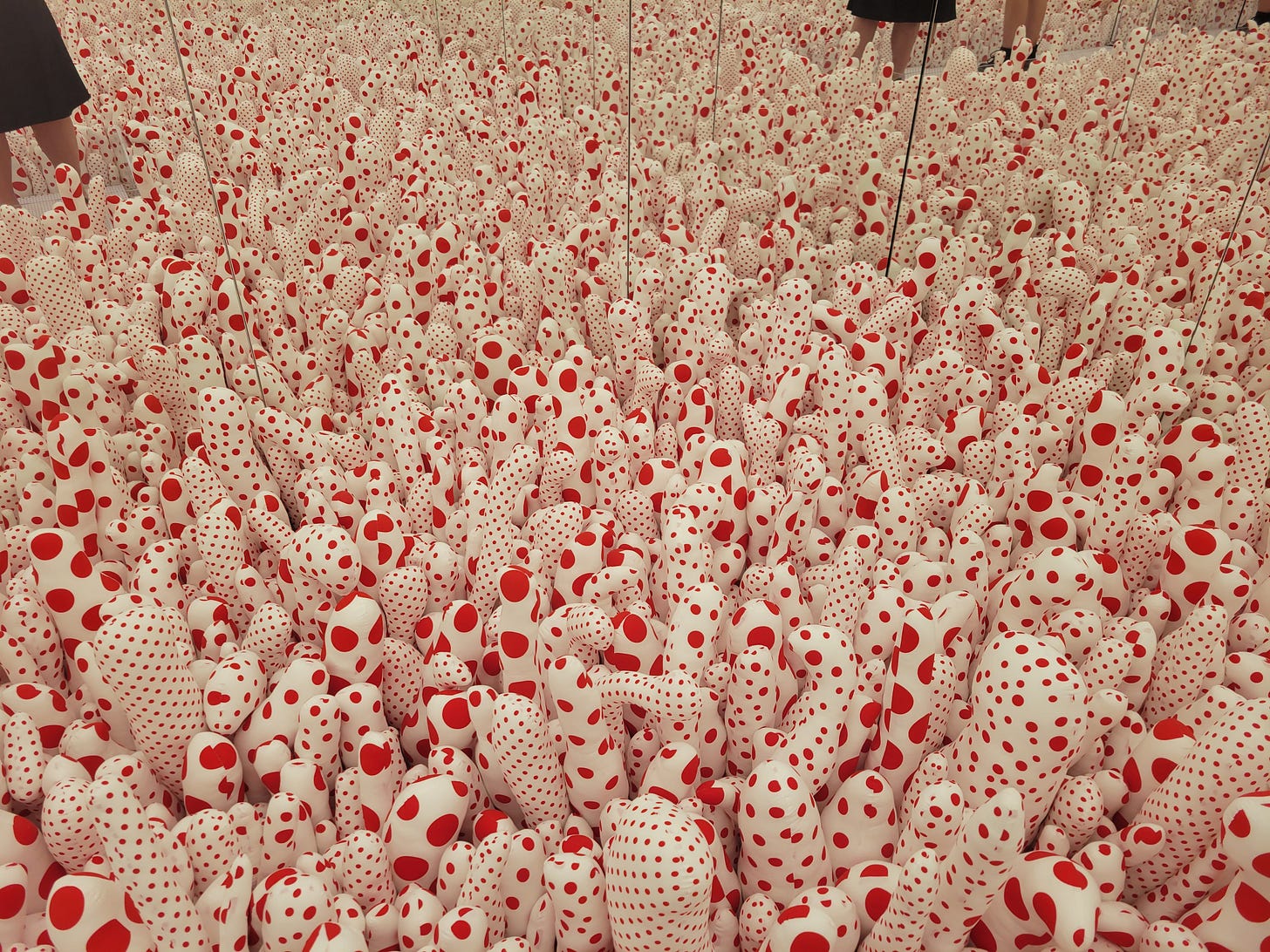Going All-City: What Writers Can Learn from Artists
Advice from a street artist about getting your work out there, inspiring female artists, and The Idiot returns
Twice this spring, I traveled to one of my favorite cities, Washington D.C. In college, I spent a semester there working as a research assistant for David Luban, a law professor at Georgetown and a visiting scholar at the Woodrow Wilson Center for International Scholars. He was an ethicist, working on a book about Hannah Arendt’s theory of the banality of evil. Every day I met him in his office in the turret of the Smithsonian castle, found out what he wanted me to dig into, and then went over to the Library of Congress to request the materials. The Jefferson Reading Room is heaven for the book besotted, and I loved visiting it again.
I also enjoyed graffiti spotting in D.C. I’ve been working on a novel about graffiti artists for many years, and I enjoy considering what writers can learn from graffiti artists, who in their lingo are also called “writers.” I spotted this throw-up by JACK near our hotel.
A throw-up is graffiti that is a little more elaborate than a tag (the artist’s painted signature) but not as intricate as a piece (a mural, short for masterpiece). As you can see, JACK painted his throw-up in a tricky place on the top of his building. Then I spotted him again, on a bridge over the water in Georgetown.
I have no idea how he did this—there doesn’t appear to be a ledge. I wonder if he had a rope? In the graffiti world, there are three basic ways to gain credibility. One way is to just get your tag up everywhere—to “go all-city.” This is done as quickly as possible, and it isn’t lovely. It’s the stuff that annoys people. Think of it as the equivalent of all those James Patterson books being churned out at the James Patterson factory, appearing everywhere all the time.
Another way to gain credibility is to complete the most beautiful, intricate, or original pieces. Graf writers become known for their signature styles—and I think this would be the equivalent of literary writing, the stuff that wins prizes.
The third way is JACK’s method—to paint daredevil throw-ups that make everyone wonder how the heck he did it. And graf writers scale walls, hang from bridges, perch on scaffolding, and otherwise take risks to gain this third type of renown. I don’t know what the equivalent of this would be for writers—maybe those memoirists who engage in super risky behavior and then write a tell-all about it?
One of my favorite Denver street artists is DETOUR, also known as Thomas Evans. I own one of his paintings, and enjoy his lessons on how to be an artist that he provides in his book Be the Artist and on Instagram through his Art Tip Tuesday series. One piece of advice DETOUR gives is to just get your art out there anyway you can. He says to go around asking business owners if you can paint their walls. (DETOUR doesn’t do anything illegal! Unlike JACK.) DETOUR says that if you get your art out there, more and more opportunities will start to blossom from it.
I asked myself how to translate his advice for writers. One way to take it is to self-publish your work if you’ve experienced roadblocks with traditional publishing. Self-publishing has never felt right for me, though, so I translated his advice into writing in as many genres as I can, submitting as often as I can, saying yes whenever I can, as I just try to keep getting my writing out there. Hey, do you have a wall I can write on?
The Assorted Whimsy Portion of The Tumbleweed
Last week, I visited the Hirshhorn Museum, which is full of whimsy in its two temporary exhibits featuring Laurie Anderson (which I saw twice) and Yayoi Kusama. I love to see women artists taking up lots of space, being weird, and having fun.
Kusama is a brilliant 93-year-old artist with a storied career and a yen for pumpkins, polkadots, and mirrored rooms.
Several of the exhibits required visitors to wait to enter a mirrored room in small groups. The mirrors amplified the sculptures—glowing polkadot lanterns and in one called “Accumulations,” a collection of soft-sculptures that the brochures referred to as “phallus forms.”
I thought they just looked like little polkadot creatures and I very much enjoyed my two minutes with them.
The Book Recommending Portion of The Tumbleweed
Have you read The Idiot by Elif Batuman yet? This is how I described it for the Dallas Morning News:
My friend once showed me a picture of herself captured at the height of adolescent awkwardness, a photo most of us would hide, disavow, or burn. She told me she sometimes spoke to the picture. "I tell her, 'You're going to be okay.'" The Idiot, Elif Batuman's charming, hilarious and wise debut novel, is like a book version of that picture, a portrait of a nineteen-year-old aspiring writer named Selin who has an utterly original way of looking at the world, and a knack for getting herself into awkward situations.
It’s about the only novel set at Harvard that I’ve ever loved, until her sequel, Either/Or came out last month. That makes two novels set at Harvard that I’ve enjoyed. I reviewed it for The Minneapolis Star Tribune, writing about how part of the plot involves Selin trying to get over her freshman-year crush, Ivan:
Selin embarks on a quest to move past Ivan, get her groove back and enjoy a hot girl summer, but these classic literary-heroine pursuits will play out in entirely unexpected and hilarious ways, in part because Selin's so skilled at noticing flourishes of the bizarre within the mundane. "Could its name really have been 'Grimace'?" she asks of the cheerful purple McDonald's blob.
If you’re looking for something long and funny to read, go out and have an Idiot/ Either/Or summer.
The Q&A Portion of The Tumbleweed
During this year’s Lighthouse Writers Workshop Lit Fest, which we’re in the middle of, I am teaching more than a hundred students in my six classes. That means I am receiving a flurry of interesting questions. Here’s one:
Q: I was offered a publication in an anthology for one poem and given third place and publication for an essay from a literary magazine. My question is, do I hold out for a bigger/better publication (not having any idea how reputable these are) or do I jump on this and accept? I’m so grateful that I’m in this position but I want to be sure that I give the best audience to these two works that are very special to me.
A: My advice is to start at the top with your submissions. Send your piece to ten top tier places at once (whatever that means to you—your favorite literary magazines) and then replace every time you have a rejection. Then, once you get an acceptance, remove it from consideration at all other places. But it often takes years to move down the tiers like this—sometimes it takes me five years to place a story, but at least I know it's being published at the top place I could manage. If you want the process to go faster, mix it up—send it to five top tier places and five up-and-coming magazines and see what happens. Normally you can republish pieces in anthologies after they run in literary magazines, so in the future, maybe submit to literary magazines first. Once you’ve already submitted to a publication and have been accepted, it’s good form to agree, unless your piece has simultaneously been accepted elsewhere, and then you can choose which one you like better. But be honest and communicative with the editors of the magazines.
That said, it's up to you. Check out the publications and see if you'd be proud to have your work there. I don't know a ton about poetry publishing, but I know that poets submit their poems in groups of five, and as one poem or another is accepted, they let the magazines know to pull that particular one from consideration, and that's standard. Most importantly, enjoy this good news and validation!
Please send me any questions you’ve got about writing, editing, publishing, rabbit keeping, gardening, taco eating and naps. You can leave a comment or send me an email.
The Self-Promotional Portion of The Tumbleweed
Lighthouse Writers Workshop’s annual Lit Fest is happening now, and several of my classes and panels are still open for registration! I'm teaching a bunch at Lighthouse HQ (3833 Steele St., Suite 1438, Denver, CO).
Getting Published: Stories, Essays, Articles and Books, Wednesday, June 15, 4:00 p.m. - 6:00 p.m.
How to Make the Most of Feedback w/ André Hoilette, Rayhané Sanders (Massie & McQuillan), Denise Vega (moderator) & Jenny Shank, Friday, June 17, 12-1 p.m., also on Zoom
Laughing for Change: Funny Stories with Serious Purpose, Saturday, June 18, 1:30 p.m. - 3:30 p.m.
Personal Essays with a Twist, Saturday, June 18, 4:00 p.m. - 6:00 p.m.
Navigating the Lows of Your Writing Career: Panel Discussion, Sunday, June 19, 12:00 p.m. - 1:00 p.m.
Mixed Company is a finalist for the Colorado Book Award in the General Fiction category! Come to the award celebration on Saturday, June 25 at Ellie Caulkins Opera House Studio Loft (980 14th Street, Denver, CO, 4:30 pm). There will be appetizers by chef Kevin Taylor, book signings and more.
I’ll be participating in the Denver Public Library’s Denver Days program with a talk at the brand new Bob Ragland Branch near RINO on August 5 at 4:30.











Ciao Jenny, what's the name of your novel about graffiti artists? I want to read it! 😁
Saw you from afar at LitFest but didn't get a chance to say hello. Thanks for sharing the photos from the Yayoi Kusama exhibit. I kind of what to go to DC just to walk among the polkadot phallus forms. Fascinating! I'm also going to give The Idiot another try. Maybe I wasn't in the right frame of mind?